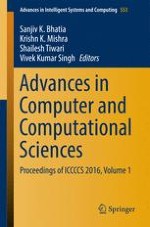Exchange of information and innovative ideas are necessary to accelerate the development of technology. With advent of technology, intelligent and soft computing techniques came into existence with a wide scope of implementation in engineering sciences. Keeping this ideology in preference, this book includes the insights that reflect the ‘Advances in Computer and Computational Sciences’ from upcoming researchers and leading academicians across the globe. It contains high-quality peer-reviewed papers of ‘International Conference on Computer, Communication and Computational Sciences (ICCCCS 2016), held during 12-13 August, 2016 in Ajmer, India. These papers are arranged in the form of chapters. The content of the book is divided into two volumes that cover variety of topics such as intelligent hardware and software design, advanced communications, power and energy optimization, intelligent techniques used in internet of things, intelligent image processing, advanced software engineering, evolutionary and soft computing, security and many more. This book helps the perspective readers’ from computer industry and academia to derive the advances of next generation computer and communication technology and shape them into real life applications.
